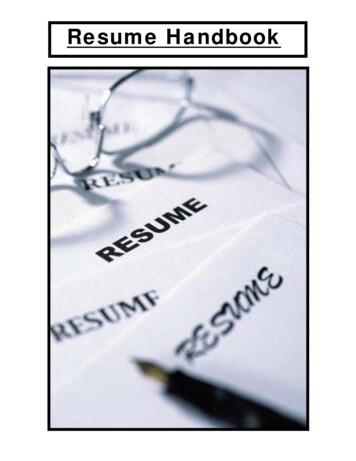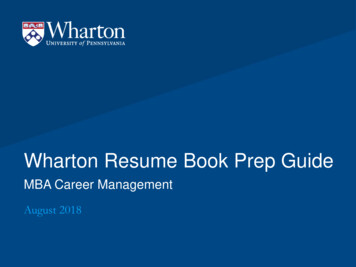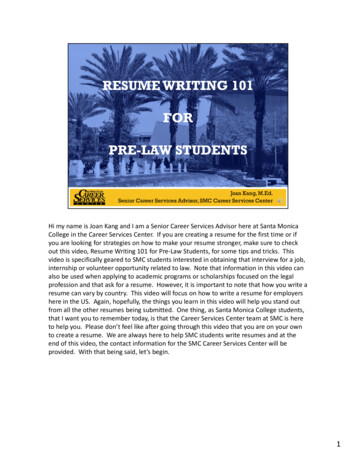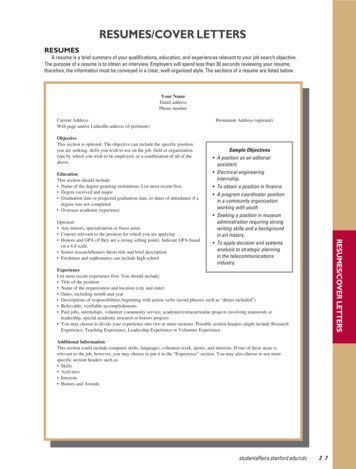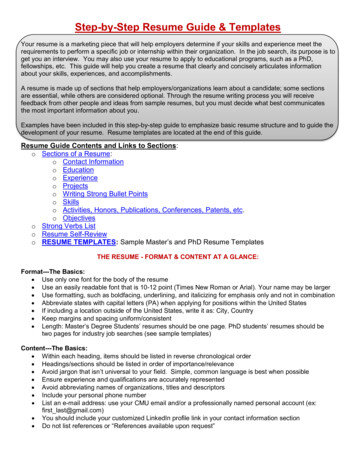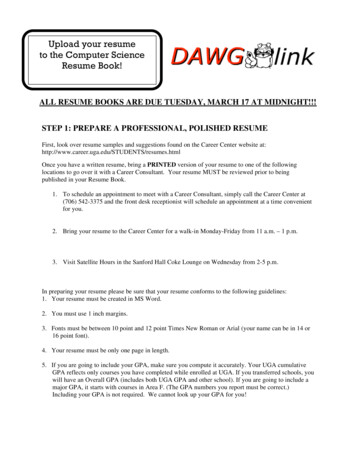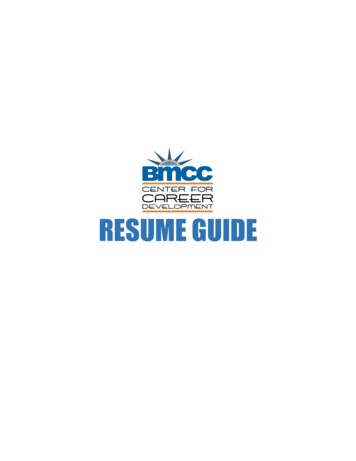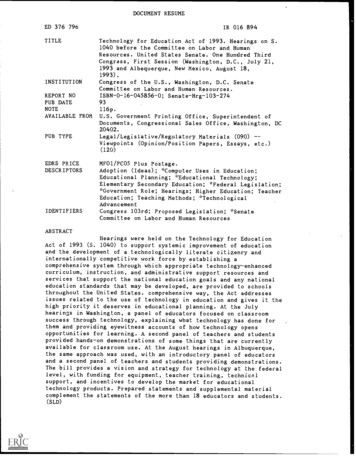
Transcription
DOCUMENT RESUMEED 376 796IR 016 894TITLETechnology for Education Act of 1993. Hearings on S.1040 before the Committee on Labor and HumanResources. United States Senate. One Hundred ThirdCongress, First Session (Washington, D.C., July 21,1993 and Albequerque, New Mexico, August 18,INSTITUTIONCongress of the U.S., Washington, D.C. SenateCommittee on Labor and Human Resources.ISBN-0-16-045856-0; Senate-Hrg-103-2741993).REPORT NOPUB DATENOTEAVAILABLE FROM93116p.U.S. Government Printing Office, Superintendent ofDocuments, Congressional Sales Office, Washington, DC20402.PUB TYPELegal/Legislative/Regulatory Materials (090)Viewpoints (Opinion/Position Papers, Essays, etc.)(120)EDRS PRICEDESCRIPTORSIDENTIFIERSMF01/PC05 Plus Postage.Adoption (Ideas).; *Computer Uses in Education;Educational Planning; *Educational Technology;Elementary Secondary Education; *Federal Legislation;*Government Role; Hearings; Higher Education; TeacherEducation; Teaching Methods; *TechnologicalAdvancementCongress 103rd; Proposed Legislation; *SenateCommittee on Labor and Human ResourcesABSTRACTHearings were held on the Technology for EducationAct of 1993 (S. 1040) to support systemic improvement of educationand the development of a technologically literate citizenry andinternationally competitive work force by establishing acomprehensive system through which appropriate technology-enhancedcurriculum, instruction, and administrative support resources andservices that support the national education goals and any nationaleducation standards that may be developed, are provided to schoolsthroughout the United States. comprehensive way, the Act addressesissues related to the use of technology in education and gives it thehigh priority it deserves in educational planning. At the Julyhearings in Washington, a panel of educators focused on classroomsuccess through technology, explaining what technology has done forthem and providing eyewitness accounts of how technology opensopportunities for learning. A second panel of teachers and studentsprovided hands-on demonstrations of some things that are currentlyavailable for classroom use. At the August hearings in Albuquerque,the same approach was used, with an introductory panel of educatorsand a second panel of teachers and students providing demonstrations.The bill provides a vision and strategy for technology at the federallevel, with funding for equipment, teacher training, technicR1support, and incentives to develop the market for educationaltechnology products. Prepared statements and supplemental materialcomplement the statements of the more than 18 educators and students.(SLD)
S. HRG. 103-274TECHNOLOGY FOR EDUCATION ACT OF 1993U.S. DEPARTMENT OF EDUCATIONOnce 01 Educational Research and improvementEDUCATIONAL RESOURCES INFORMATIONCENTER (ERIC)0 Th,s doct -nem has been reproduced asrece.ved Iron the person or orgarnzahonongmahngO Mmor changes have been made to improvereproduction qualityPoints of rie Or Opinions stated in !Ns docu,rnent do not necessarily represent MoatHEARINGSBEFORE THEOE RI Posrhon or pohcyceCOMMITTEE ONLABOR AND HUMAN RESOURCESUNITED STATES SENATE0)ONE HUNDRED THIRD CONGRESStiFIRST SESSIONtGONS. 1040TO SUPPORT SYSTEMIC IMPROVEMENT OF EDUCATION AND THE DEVELOPMENT OF A TECHNOLOGICALLY LITERATE CITIZENRY ANDINTERNATIONALLY COMPETITIVE WORK FORCE BY ESTABLISHING ACOMPREHENSIVE SYSTEM THROUGH WHICH APPROPRIATE TECHNOLOGY-ENHANCED CURRICULUM, INSTRUCTION, AND ADMINISTRATIVE SUPPORT RESOURCES AND SERVICES, THAT SUPPORT THE NATIONAL EDUCATION GOALS AND ANY NATIONAL EDUCATION STAND-ARDS THAT MAY BE DEVELOPED, ARE PROVIDED TO SCHOOLSTHROUGHOUT THE UNITED STATESJULY 21, 1993 WASHINGTON, DCAUGUST 18, 1993 ALBUQUERQUE, NMPrinted for the use of the Committee on Labor and Human ResourcesBEST COPY AVAILABLEU.S. GOVERNMENT PRINTING OFFICE0-787ecWASHINGTON . 1993For sale by the U.S. Government Pnnting OfficeSuperintendent of Documents. Congressional Sales Office. Washington. DC 20402ISBN 0- 16.045856.0
!P.COMMITTEE ON LABOR AND HUMAN RESOURCESEDWARD M. KENNEDY,CLAIBORNE PELL, Rhode IslandHOWARD M. METZENBAUM, OhioCHRISTOPHER J. DODD, ConnecticutPAUL SIMON, IllinoisTOM HARKIN, IowaBARBARA A. MIKULSKI, MarylandJEFF BINGAMAN, New MexicoPAUL D. WELLS-TONE, MinnesotaHARRIS WOFFORD, PennsylvaniaMassachusetts, ChairmanNANCY LANDON KASSEBAUM, KansasJAMES M. JEFFORDS, VermontDAN COATS, IndianaJUDD GREGG, New HampshireSTROM THURMOND, South CarolinaORRIN G. HATCH, UtahDAVE DURENBERGER, MinnesotaNICK LITTLEFIELD, Staff Director and Chief CounselStisoz K. HATrAN, Minority Staff Director(II,3
CONTENTSSTATEMENTSJULY 21, 1993Kennedy, Hon. Edward M., a U.S. Senator from the State of MassachusettsBingaman, Hon. Jeff, a U.S. Senator from the State of New Mexico, preparedstatementPell, Hon. Claiborne, a U.S. Senator from the State of Rhode IslandStogsdill, Julie, project coordinator, Buddy System Project, Indianapolis, IN;Annemarie Ryan, teacher, Charlestown High School, Charlestown, MA;Lea Anne Brandon and Jerry L. Kitchings, Hayes Cooper Center for Math,Science and Technology, Merigold, MS; Geraldine Dirks and Philip Royball,Pojoacfue High School, NM; and Valerie Wilford, executive director, IllinoisValley Library SystemPrepared statements:Ms. Brandon and Mr. Kitchinga (with attachments)Ms. DirksMs. WilfordJeffords, Hon. James M., a U.S. Senator from the State of Vermont ., .Johnson, Stanley, teacher, Thomas Jefferson Junior High School, Washington,DC, accompanied by Jacqueline Fisher and Lateef Abney, students; JohnKernan, chairman, Jostens Learning Corp., accompanied by W.H. GeraldPage135613242936Caldwell, Jr., EduQuest Marketing Programs and support director, andJeffrey H. Orloff, manager, national programs marketing for Apple; RickLane, co-founder, Modern Educational Technology Center, accompanied byMichael S. Swetnam, GTE Information Processing Systems, ValerieThames, teacher, and Audrey Hillman, studentPrepared statements:Association of America's Public Television StationsMr. KernanMr. Swetnam40426057ADDITIONAL MATERIALArticles, publications, letters, etc.:Answers to questions of Senator Simon from Valerie WilfordStatements:Tom TaukeStanley D. ZenorAmerican Psychological AssociationBusiness Software AllianceJeanne HayesLetters to:Committee on Labor and Human Resources, from Arthur G. Hansen,president emeritus, Purdue UniversityMarvin Bailey, president of the Buddy Project, from R. Stephen Gookins5969626365667374
IVPageAUGUST 18, 1993ALBUQUERQUE, NMBingaman, Hon. Jeff, a U.S. Senator from the State of New MexicoCasados, Benito, executive director of educational systems for the GalaxyClassroom Project; Christina Esguibel, Chapter 1 teacher, Tierra AmarillaElementary School, Tierra Arnarilla, NM; Donna Fullerton, Las CrucesTake Home Computer Program, Partners in Learning Program; DoraGalvez, parent at Washington Elementary; Belinda Galvez, student; ErikaEwbank, reading teacher at Washington Elementary; an David Caffey,77Clovis Community College; accompanied by Mike Chambers, San Jon79Media Literacy Project, accompanied by Angelica DePaule, Kathy Valenciaand Tom Tischler, students; Arden Coleston, interpreter; Lucy Holloway,Josten's Learning; and Consuelo Gonzales, teacher at the Academy of Communications, Arts, and Technology at Santa Fe High; accompanied by Justin Lathrop, Frank Cox, and Cameron Stoker, students96Brighton, Jane, teacher, New Mexico School for the Deaf, on behalf of theADDITIONAL MATERIALArticles, publications, letters, etc.:Statement of Margaret Evans GayleLetter to Margaret Evans Gayle, president, Triangle Management Group,from Frank Press, president, National Academy of Sciems, June 4,1993Statement of Kathryn Harris Tijerina107110110
TECHNOLOGY FOR EDUCATION ACT OF 1993WEDNESDAY, JULY 21, 1993U.S. SENATE,COMMITTEE ON LABOR AND HUMAN RESOURCES,Washington, DC.The committee met, pursuant to notice, at 10:00 a.m., in roomSD-430, Dirksen Senate Office Building, Senator Bingaman, presiding.Present: Senators Kennedy, Bingamani, and Jeffords.Senator BB1GAMAN [presiding.] The hearing will come to order.I am in the unusual position of chairing a hearing in SenatorKennedy's committee here because he has to leave very shortly, sobefore I even give an opening statement, let me call on SenatorKennedy to make his statement, because he does have the U.S. Supreme Court nominee hearing going on at the same time.Senator Kennedy.OPENING STATEMENT OF SENATOR KENNEDYThe CHAIRMAN. Thank you very much, Mr. Chairman.At the outset of this hearing, I want to pay tribute to Jeff Bingaman for the leadership that he has been providing in the areas oftechnology and education, and understanding the importance of acomprehensive approach to this issue. We are working very closelytogether, and I think this is one of the real priority pieces of legislation for this committee and, most important, for the country.We want to express our appreciation to all of the witnesses whoare here this morning. We have a very varied group of witnesses,including some young students who will put on a presentation forus, and I am grateful to all of them for being here. We want to givethem the assurance that Senator Wngaman and I have been meeting with Secretary Riley and Madeleine Kunin, as well as representatives at the White House about the importance of this legislation. We are working with members of the commerce Committee,who have some different technology issues that are moving along.But we want to give them our assurance that this is something ofgreat importance to Senator Bingaman and myself, as well as theother members of the committee, and we value very highly thecomments and the testimony that will be given today.I'll just take a moment, and I apologize to the witnesses for notbeing able to be here, particularly to Annemarie Ryan, from Massachusetts, a teacher at Charlestown High School. Given the level ofinterest in Boston and in Massachusetts generally, and the workthat has been done out in the field in this area over a long period(1)
2of time, we plan to have an additional hearing up in Boston laterin the session.As Senator Bingaman mentioned, we have Judge Ginsburg, theU.S. Supreme Court nominee, in the Judiciary Committee thismorning, as well as the Armed Services Committee, which both ofus are members of, so we are pressed in terms of time, and weapolmiCze.Today we address an issue that has potential to improve classrooms throughout the countryeducational technology. We talkoften about world class standards and international competitiveness, but the reality is that the vast majority of pupils are tryingto learn in the 1990's with technology that is out-of-date.The schools of today cannot teach with the technology of yesterday. We have seen that particularly in our Boston schools. In fewother institutions in our society do professionals have such limitedaccess to modern technology as teachers in schools especially in ourpoorest districts. S. 1040 can change that.At the hearing today, we will hear from teachers like AnnemarieRyan, who taught for many years al Charlestowa High School inMassachusetts and now teaches otht. teachers t') integrate technology in their lessons. By creative uses of technology, she hasdemonstrated that all children can learn and that all teachers canlearn as well. It is not enough to drill children in numbers andfacts, or with pencil and paper. Through technology, Annemarieand many Boston teachers have deepened their own understandingof mathematics and help one another pass that understanding onto their students. And by sharing those concepts and techniqueswith others, they are preparing students to think and solve problems on their own.They are part of a movement in many parts of the country thatis helping to transform the Nation's schools one by one, by creatinga new climate of learning and intellectual stimulation.The need for this bill has been amply documented. E'en inwealthy districts, technology is often unavailable, or used ineffec-tively. In January 199t, Education Week reported that the highcost of purchasing, maintaining, and upgrading equipment, thelack of adequate software that dovetails with teacher curriculumneeds, the absence of assessments that reflect the complex thinkingskills and the dearth of teacher training all work against innovative use of technology in schools.In a comprehensive way, the Technology for Education Act addresses all of these issues and gives technology the high priority itdeserves in contemporary American education.I commend Senator Bingaman for his leadership in developingand introducing this bill, and I commend Senator Cochran as well.The legislation has received impressive bipartisan support, and Ilook forward to today's testimony and to early action on this important bill.I thank you, Mr. Chairman.Senator BINGAMAN. Thank you very much.I am sure everyone here is well aware that Senator Kennedy isthe pioneer who started the STAR Schools Program and got thatgoing. We are trying to build on that very auspicious start, andi what the legislation is about. He was too modest in givingthat is
3me credit for developing the bill; he had a major part in that, andhis staff worked very hard with my staff in the drafting of it. SoI do think this is an area where we can make progress and onethat the Federal Government can make a great contribution in.So thank you very much for your statement, Senator Kennedy.The CHAIRMAN. Thank you very much.OPENING STATEMENT OF SENATOR BINGAMANSenator BINGAMAN. I will go ahead with a very short statementmyself, and then we'll get on with the witnesses. As everybody cansee, we have a lot of interest in this subject, and we have a greatmany witnessesvery good witnessesand unfortunately, we needto finish the hearing by 12.The hearing is focused on S. 1040, which is the Technology forEducation Act of 1993. The idea of this hearing is to make otherSenators and people who observe the hearing believers in the valueof educational technology as a way to help with education in ourcountry.I am very grateful that Senator Kennedy permitted this hearingto be scheduled at this time. There is a great deal of other businessgoing on here in the Senate, but we wanted to get this done earlyso we can hopefully move the legislation this year.We have taken a slightly different tack in composing our panelsthis year. The goal was to really catch the imagination of peopleabout the possibilities that technology presents in transforming theNation's classrooms into laboratories for creative learning. We hopethat there will be a real appetite for and an interest stimulated forthe innovative use of technology in the schools as a result of ourhearing.We have asked our first panel to focus on classroom successthrough technology. In essence, they will tell firsthand what tech-nology has done for them, and in particular circumstances, thepanel of students, teachers and administrators can give eyewitnessaccounts of how technology has changed their lives and opened theopportunities to explore the world of learning.Then we'll have a second panel that will focus on hands-on dem-onstrations of what is currently available for classroom use.Through students and teachers that we have asked to be heretoday, we can witness some of the exciting opportunities that areavailable to schools when the resources are provided.As you will witness today, technology can make a tremendousdifference in the quality of education we present to our children.S. 1040 is intended to be a vehicle for funnelling Federal supportand assistance to State and local schools. The bill provides a visionand a strategy at the Federal level with funding to ease the effortsby State and local school districts to provide equipment, teachertraining, technical support, as well as incentives to cevelop themarket for educational products along the lines that are involvedin the testimony today.Let me make .a couple of housekeeping announcements before webegin. We are going to accept additional written testimony fromother organizations which will be sent in in the next 30 days. Ifpeople in the audience do wish to make their views known, please8
ti4send that to the committee, and we'll try to include that in therecord.Let me also just State for the witnessesI know this has beenemphasized to you beforethat because of the large number of witnesses and the desire to hear from everybody, we will include everyone's written statement in the record and ask if you could summarize those statements in a few minutes. I think that will be thebest way to proceed.[The prepared statement of Senators Bingaman and Pell follow:]PREPARED STATEMENT OF SENATOR BINGAMANGood morning, and welcome to today's hearing on S. 1040, theTechnology for Education Act of 1993. I believe that what you willsee and hear today will make you a "believer" in educational technology and motivate you, as it has me, to press for creative waysto extend these innovative programs to each and every child inAmerica. I am grateful to the Chairman of the Senate's Committeeon Labor and Human Resources, Mr. Kennedy, for sanctioning thishearing. I understand that Senator Kennedy will join us shortly.I'm excited about today's hearing because we have taken a slightly different tack with the composition of ou? panels. Our goal withthis hearing is to captivate your imagination to give you a taste ofthe endless possibilities through technology to transform our nation's classroomsto exciting laboratories for creative learning.We hope to peak your interest and stimulate your appetite for in-novative uses of technology for our children, their parents andteachers. If we have done our job right, you will walk away fromthis hearing with more questions than answersmore informationthan you can possibly process in these two short hours!Today's hearing should be a walk on the other side of the lookingglassleaving behind the traditional classroom in our brief journey.We have asked our first panel to focus on classroom successthrough technology. In essence, they will tell you, first-hand, "whattechnology has done for me." Our panel of students, teachers, administrators will give eye-witness accounts of how technology haschanged their lives and opened endless opportunities to explore theworld of learning.The second panel will focus on "what technology can do for you"through a hands-on demonstration of what is currently availablefor classroom use. Through the students and teachers we've askedhere today, we will witness what exciting opportunities await ournation's schools through technology. We even have an example ofhow defense technology applications have been modified for classroom use.We will see demonstrations of state of the art equipment andcomplementary software packages, as well as a program enablingteachers to tailor the curriculum to the swiftly changing flow of information and the individual needs of the students.As you will witness today, creative uses of technology by skilledteachers can change our outlook on educationmaking teachersand students partners in the quest for knowledge and the processfor learning. Our problem, however, is that too few of these examples exist in the classrooms across our Nation.9
5We could point the finger of blame to any number of factors; but,for whatever the reasons, our job at the federal level should be toease the burden on the state and local schools and to provide leadership and assistance in their efforts to reach the National Education Goals by the year 2000. Providing educational technology isone of the most cost-effective means by which the Federal Government can assist States and local school districts to meet the ambi-tious pals.S. 1040 provides the vehiclethe meansto funnel this supportto the state and local level. The educational reform effort we, as anation, are currently undertaking must be grounded with the goalof equity and access for all of America's school children. Our billis, by no means, the solution to the serious problem of inequity inour school systems across America. We believe, however, that weprovide the first critical step.This bill provides a vision and strategy at the federal level, withfunding to ease the effort by the State and local school districts toprovide equipment, teacher training, and technical support, as wellas incentives to develop the market for educational productsalongthe lines of what you will see here today.I want to thank you all for your attendance, and I look forwardto an excellent morning of discovery.PREPARED STATEMENT OF SENATOR PELLI would like to commend Senator Bingaman for his interest andleadership in this most important and intriguing area. With resources scarce, inequities present, and achievement, needing im-provement, technology can play a tremendous role in advancing equity and excellence in general education. and I regret I am unableto attend the hearing today.As some of you know, in last year's Office of Educational Research and Improvement reauthorization, we provided for the creation of an Office of Educational Technology to pull together thedifferent technology support programs currently in the Departmentof Education and to provide recommendations for future technologypolicy development. I understand this remains an area of consensus and hope the proposal will move forward.I would be remiss, however, if I did -not point out that technologyis not a substitute for an enthusiastic, qualified and competentteacher. Technology in the classroom should enhance and supplement teacher instruction. Toward that end, classroom educatorsshould be provided with significant professional development opportunities. If teachers are intimidated by technology, they are notlikely to utilize it in the classroom.A technology initiative for in-class instruction must be encompassed by careful planning, provisions for ongoing maintenance,compatibility of hardware that can be easily upgraded, and as Isaid, substantial staff development. This legislation does that andmore. It is an important component in providing students a worldclass education.Senator B1NGAMAN. I will call upon the first panel to presenttheir testimonies, and I will withhold questions until we finishhearing from the entire panel.0
6Julie Stogsdill is with the Buddy System Project in Indiana andis someone I have known for many years. She had a great part ingetting me elected to this job, and I appreciate that, back when shelived in New Mexico. So I appreciate her being here.Why don't we start with you, Julie?STATEMENTS OF JULIE STOGSDILL, PROJECT COORDINATOR,BUDDY SYSTEM PROJECT, INDIANAPOLIS, IN; ANNEMARIERYAN, TEACHER, CHARLESTOWN HIGH SCHOOL, CHARLESTOWN, MA; LEA ANNE BRANDON AND JERRY L. KITCHINGS,HAYES COOPER CENTER FOR MATH, SCIENCE AND TECHNOLOGY, MERIGOLD, MS; GERALDINE DIRKS AND PHILIPROYBALL, POJOAQUE HIGH SCHOOL, NM; AND VALERIEVTMFORD, EXECUTIVE DIRECTOR, ILLINOIS VALLEY LIBRARY SYSTEMMs. STOGSDILL. I am honored to represent the Buddy SystemProject, the largest, and we believe the most innovative educationaltechnology program in the United States today.Buddy began in 1988 in five 4th grade classrooms in Indiana,and when we begin school next month, Buddy will reach 4th, 5thand 6th grade students at 50 sites in 22 Indiana school districts.The video that you are going to see will hopefully convey the excitement and the ,joy of learning that we find evident throughoutthe Buddy System.Senator BINGAMAN. OK, we have a video now.[Videotape shown.]Senator BINGAMAN. Does that complete your presentation?Ms. STOGSDILL. Yes, that's correct.Senator BINGAMAN. OK. We'll have some questions later.Senator BINGAMAN. Next, we'll hear from three schools in Massa-chusetts, Mississippi, and New Mexico. Annemarie Ryan is a teach-er from Charlestown High School in Massachusetts. Lea AnneBrandon is an information specialist, and Jerry Kitchings is theprincipal from Hayes Cooper Center in Mississippi, and GerryDirks and Philip R,' oyball are a teacher and student team fromPojoaque High School in New Mexico.Let's hear from Annemarie Ryan next.Ms. RYAN. I hope you understand that as a teacher and also arestructuring coordinator for the high schools in Boston, it is verydifficult for a teacher to talk for such a short period of time.Senator BINGAMAN. Well, it is hard for people in Congress, also.[Laughter.]Ms. RYAN. We'll try.I am speaking to the classroom successes, and Boston has cer-tainly, led that effort for many years now. The Office of Technologyin the Boston public schools has for many years tried to breakdown the walls of the classroom, and they have done so in fourprojects I'd like to briefly describe to you today.Those four projects are changing how and what we teach. Theyare acronyms: TEAMS, EMMAT, Project SMART and BOSNET.TEAMS stands for Telecommunications Education for Advancesin Math and Science, which is a federally funded program throughthe STAR schools. It is interactive distance learning via satellite,A11
7with L.A., originated in Los Angeles, Boston, Detroit and Washington, DC.This program teaches students how to problem solve. There areproblem solving activities. There are modules that are created forthe teachers prior to the learning. So this is not just somethingthat comes over a television and is dumped in the laps of teacherswho do not know what to do with it. There is a serious effort hereto train the teachers prior to each module.It uses manipulatives, which is very important, technology, computers, and calculators. Each module is taught over 6 to 8 weeksfrom Los Angeles. Students have the ability to call that teacher,ask questions, or offer solutions. They work on hand:' -on activities,they conduct experiments, and they call in their results and actu-ally create a community between the classmates in all of thosecities and the teachers. And in fact, two of the teachers, a mathand a science teacher, came from Hollywood to visit the schools inBoston, and it was like a star had walked into the room. Theyknew this person was on television, and they wanted his autographand the whole thing. It made the teacher feel great. Also, theywanted to share their projects.Each school gets a large-screen monitor, a VCR, a computer anda modem.The next program I'd like to speak about is EMMAT, which isalso federally funded thro.igh an NSF grant, and it is in about its5th or 6th year. It stands for Elementary and Middle Math andTechnology. And as I left my job in Boston yesterday, I left a largenumber of teachers sitting in a high school for 3 weeks, on theirown time, voluntarily learning to be an EMMAT teacher. This isthe 5th or 6th year, and in fact we have so many teachers whowant to be trained in EMMAT that we have to turn away fourtimes the number of teachers that apply because of funding and forother reasons.EMMAT is now being used in 22 middle schools and 72 elemen-tary schools. Again, it uses computers, telecommunications,manipUlatives and calculators; it focuses on problem solving, higher-level thinking skills, estimation, measurement, and geometry.The importance piece of both of these programs is that the teach-er is not the lecturer at the frontof the classroom, telling the students the answers. The point here is that the teacher is asking thestudent to solve the problem and think about how to go about it,the strategywhich is, as you know, in careers today and in thefuture, what our students need for skills.The premise here is that learning is fun. And it is funtheydon't even I:now they are learning geometry and statistics and estimation. Kids have created a geosphere, and they have put toothpicks with gumdrops in between, and they have learned a lot of geometry by doing that.In fact, what the teachers are finding is that as they are usingtelecommunication and this technology, the students are goingmore to textbooks because they want to find the answers in thetextbooks and use them as a resource. Also, because of television,students have not been doing a great deal of writing, but with tele1:ommunication, they are doing more writing because they are communicating with students in the same city, in the same school sys-12
8tern, in the same State, in the country and outside of the country.So this is a benefit. They are writing more rather than less, andthey have seen the benefit of writing.These teachers who are being trained in the EMMAT project arenot just dropped off after 3 weeks. In September, once a month,they will come together for an entire day and meet, share, reflect,talk about problems, learn new things. They also have a chance tovisit other classrooms. Former EMMAT teachers also meet on aregular basis, so the are just not let go.An important thing I would like to stress is ongoing professionalsupport and professional development. Also, the EMMAT teacherswho have been through the program who have been very successfulare used as trainers. We don't have to go out and hire consultants.We use the expertise that we have in our own system.This Federal program has allowed amazing things to happen inour classrooms. Because of the time constraints, I will not commenton SMART and BOSNET, but they are both very dynamic programs that I would like to write more to you about.I would just like to give you a few examples of what is happeningin our classrooms. We have some second graders in Boston, andthey wanted to put on a multicultural fair. So since they have asister school in Bogota, Colombia, they decided to have a live, logon telecommunications hookup at the multicultural fair. Well, itturned out to be much more interesting than they thought it wouldbe because, as you know, they personally experience effects of "ElNino," the draught, in Colombia. And their sister school only haselectricity for 3 hours a day because they are dependent on hydroelectricpower. So they got a physics lesson, they got amulticultural lesson, and it took them out of their urban community into the world where they
Jul 21, 1993 · Kennedy's committee here because he has to leave very shortly, so before I even give an opening statement, let me call on Senator Kennedy to make his statement, because he does have the U.S. Su-preme Court nominee hearing going on at the same time. Senator Kennedy. OPENING STATEMENT OF SE



